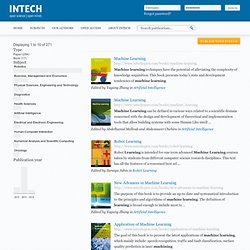

How to Start Learning Deep Learning. This post was written by Ofir.
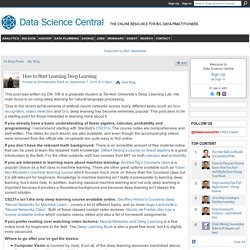
Ofir is a graduate student at Tel-Aviv University’s Deep Learning Lab. His main focus is on using deep learning for natural language processing. "Due to the recent achievements of artificial neural networks across many different tasks (such as face recognition, object detection and Go), deep learning has become extremely popular. This post aims to be a starting point for those interested in learning more about it.
If you already have a basic understanding of linear algebra, calculus, probability and programming: I recommend starting with Stanford’s CS231n. If you don’t have the relevant math background: There is an incredible amount of free material online that can be used to learn the required math knowledge. Machine Learning Books : MachineLearning. 11 open source tools for making the most of machine learning. Spam filtering, face recognition, recommendation engines -- when you have a large data set on which you’d like to perform predictive analysis or pattern recognition, machine learning is the way to go.
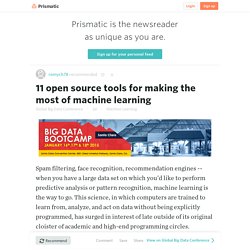
This science, in which computers are trained to learn from, analyze, and act on data without being explicitly programmed, has surged in interest of late outside of its original cloister of academic and high-end programming circles. Machine Learning. Deep Learning – important resources for learning and understanding. New and fundamental resources for learning about Deep Learning - the hottest machine learning method, which is approaching human performance level.

By Gregory Piatetsky, @kdnuggets, Aug 21, 2014. Deep Learning is the hottest machine learning method and it is very much in the news for achieving remarkable results. In the recent Large Scale Visual Recognition Challenge (results, NYTimes article), the accuracy has almost doubled (to 43.9% from 22.5%) and the error rate fell to only 6.6% from 11.7%. Significantly, almost all of the entrants used a variant of an approach known as a convolutional neural network (ConvNet), an approach first refined in 1998 by Yann LeCun, NYU professor, recently hired to head Facebook AI Research Center.
100 Most Popular Machine Learning Talks at VideoLectures.Net. Data Science. Data mining - Overwhelmed by Machine Learning. Best Machine Learning Resources for Getting Started. This was a really hard post to write because I want it to be really valuable.
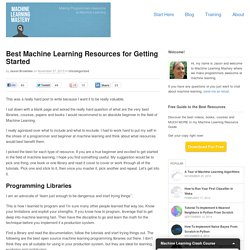
I sat down with a blank page and asked the really hard question of what are the very best libraries, courses, papers and books I would recommend to an absolute beginner in the field of Machine Learning. Dossier 02 – Machine Learning: discipline and methods. Hi there!
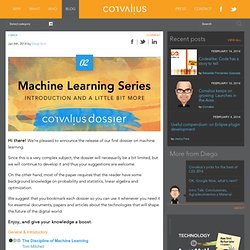
We’re pleased to announce the release of our first dossier on machine learning. Since this is a very complex subject, the dossier will necessarily be a bit limited, but we will continue to develop it and thus your suggestions are welcome. On the other hand, most of the paper requires that the reader have some background knowledge on probability and statistics, linear algebra and optimization. We suggest that you bookmark each dossier so you can use it whenever you need it for essential documents, papers and articles about the technologies that will shape the future of the digital world. Enjoy, and give your knowledge a boost. General & Introductory. (145) Pronojit Saha's answer to Data Science: What are some software and skills that every Data Scientist should know.
Mathematics of Machine Learning. Two summer readings on Big Data and Deep Learning. This is the first (short) post dedicated to the Big Data program of the Simons Institute.

We received from the program organizer Mike Jordan our first reading assignment which is a report published by the National Academy of Sciences on the “Frontiers in Massive Data Analysis“. This paper was written by a committee of academics and industrials chaired by Mike Jordan. I find the report quite interesting because it clearly identifies the new mathematical and algorithmic challenges that the Big Data point of view brings. This includes in particular many issues related to data representation, but also distributed algorithms, crowdsourcing, or tradeoffs between statistical accuracy and computational cost. Talking about data representation I would like to link another paper, this one from Stéphane Mallat, Group Invariant Scattering. Gaining access to the best machine-learning methods. For companies in the early stages of grappling with big data, the analytic lifecycle (model building, deployment, maintenance) can be daunting.
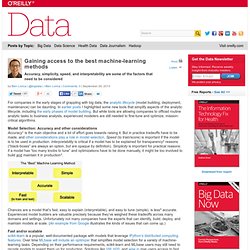
In earlier posts I highlighted some new tools that simplify aspects of the analytic lifecycle, including the early phases of model building. But while tools are allowing companies to offload routine analytic tasks to business analysts, experienced modelers are still needed to fine-tune and optimize, mission-critical algorithms. Model Selection: Accuracy and other considerationsAccuracy1 is the main objective and a lot of effort goes towards raising it. But in practice tradeoffs have to be made, and other considerations play a role in model selection. My First Deep Learning System 1991 / Deep Learning Timeline 1962-2013. In 2009, our Deep Learning Artificial Neural Networks became the first Deep Learners to win official international pattern recognition competitions [A9] (with secret test set known only to the organisers); by 2012 they had won eight of them [A12], including the first contests on object detection in large images [54] (at ICPR 2012) and image segmentation [53] (at ISBI 2012).
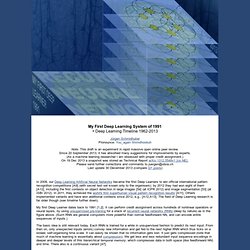
In 2011, they achieved the world's first superhuman visual pattern recognition results [A11]. Others implemented variants and have won additional contests since 2012, e.g., [A12,A13]. A Resource for Machine Learning. Free Datascience books. (9) Classification (machine learning): Are there articles that describe practical methods to select a machine learning algorithm. InTech Open Access Publisher - Open Science Open Minds. Publish with InTech.
